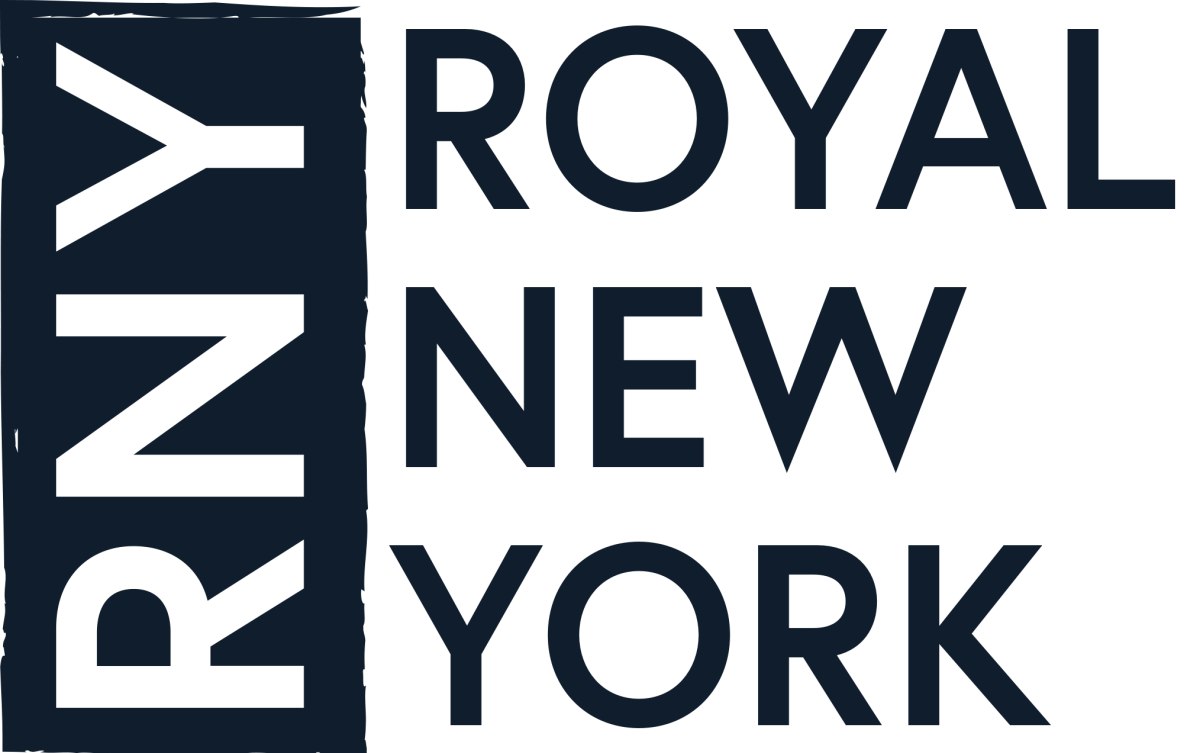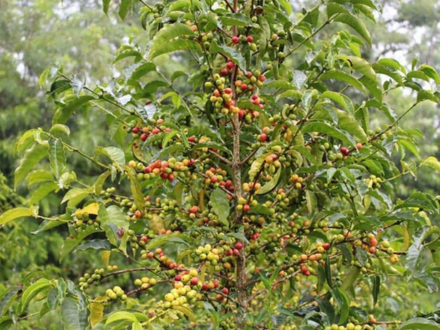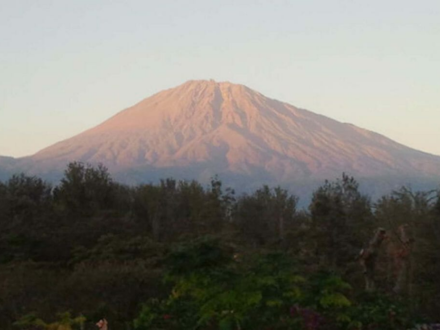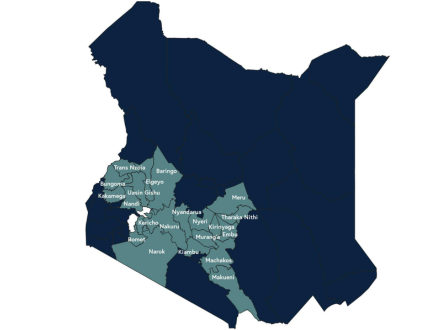July 8, 2020
Origin Profile: Ethiopia
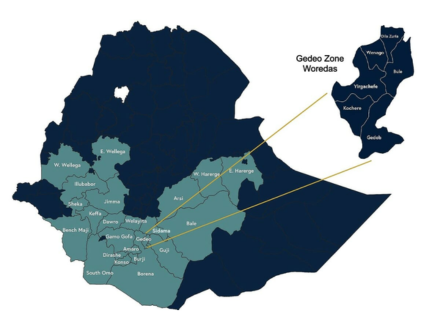
The basic facts of coffee in Ethiopia:
Production: 7.35 million 60 Kilo bags
Exports: 4 million 60-kilo bags
Primary Varieties: 1,000 – 10,000 indigenous varieties
Average Farm Size: < 1 Hectare
Maximum Elevation: 4,550m or 14,900ft
Notable Growing Regions: Yirgacheffe, Sidama, Harrar, Limu, Jimma
Harvest Season: November – February
Export Season: December – June
Overview of Coffee in Ethiopia
Geography
Ethiopia is a landlocked nation in the horn of Africa. Moreover, it is bounded by Eritrea to the North, Sudan in the west, Kenya to the South, and Somalia to the East. Djibouti is small nation on Ethiopia’s northeastern border, which is how the majority of the coffee reaches the sea. While this represents a logistical challenge when transporting coffee overland across the country which is largely done by trucks, rail is becoming increasingly viable.
The region is mountainous with five distinct geographic regions: the western highlands and lowlands, the eastern highlands and lowlands, and the rift valley. The western highlands are the most rugged and extensive and varied. On the other hand, the central massif of these highlands contains the highest point in all of Ethiopia: Mount Ras Dejen. Additionally, it is home to the Blue Nile river and Lake Tana.
Climate
Ethiopia’s climate depends heavily on elevation. On the highest peaks, the temperature does not rise above 50 degrees. In the valleys and on the slopes rainfall and temperature are higher, and there is extensive jungle and swamplands. To the east is the Denakil plain, where there is little rainfall and temperatures are high, creating desert.

For the coffee growing regions, the temperatures range between 55F and 80F, but average between 60F and 70F. The primary coffee growing regions are on the slopes where rainfall is moderate to heavy in western and central Ethiopia. They average between 800 and 2100mm of annual precipitation. Limu receives the greatest annual rainfall and Harrar receives the lowest. Sidama and Yirgacheffe receive moderate amounts of precipitation.
There are three main seasons in Ethiopia – Bega, Belg, and Kremt. Firstly, Bega is the long dry season from October to February. Coffee harvesting and processing generally occurs during Bega. Then, Belg is the next season from February to May. It is defined by intermittent rainfall similar to spring. During this time coffee trees flower and cherries begin to form. Lastly, Kremt is the season of heavy rainfall from June until September where cherry maturation accelerates.
History
The people’s history of coffee in Ethiopia begins over 1,000 years ago. In fact, the most commonly told legend involves Kaldi the goat herder. Upon noticing the energy his flock gained after feeding upon the berries of the coffee tree, Kaldi tried them himself. He experienced alertness and euphoria and brought the cherries back to the monks in his village. They declared the cherries satanic and cast them into the fire. Upon smelling the fragrance, the beans were raked from the fire and crushed to be extinguished. They were tossed into hot water and covered. The monks sampled the resulting brew and drank it through the night.

What is more certain is that the original consumers of coffee were the ancestors of the Kaffa province. Historians believe that hunters would chew the cherries for hours as a source of energy on long journeys. This tradition later shifted to mixing the ground coffee with animal fats or ghee as a form of early energy bar. Eating the coffee became less popular as people discovered the ability to make it into a beverage. Some fermented the cherries into wine, while others roasted the seeds and crushed them. They boiled the coffee and consumed the resulting brew.
Coffee began to be traded outside of Africa in the 16th century when Somali merchants brought the coffee to the port of Mocha in Yemen before spreading around the world.
Growing Regions for Coffee in Ethiopia

Ethiopia is one of the only places where coffee grows wild. Approximately 85% of Ethiopia’s coffee is produced by small farmers on less than 1 hectare of land. Coffee harvesting can be divided into 4 categories – forest, semi-forest, garden, or estate. Forested coffee represents truly wild coffee that is unmaintained and has no owner. Semi-forested coffee represents coffee that is wild grown, but the area is now maintained by a local farmer in the form of weeding or pruning. Garden coffee has been planted and is maintained generally in the vicinity of the farmers residence alongside crops like false banana and papaya. They use traditional practices for fertilization and pest control that are organic in nature but generally lack the
Organic certification because of barriers related to cost and infrastructure. Estate coffee represents the smallest part of the Ethiopian coffee economy. These estates are owned and operated by the government, by foreign investors, or in some cases Ethiopian families. They would be the most at risk for exposure to chemical fertilizers or pesticides.

Yirgacheffe is the most widely recognized Ethiopian coffee growing area because of the prevalence of the washed processing style. Washing the coffee produces a delicate, clean, and complex flavor profile. This coffee tends to be fruity or floral with a lighter body.
Coffees from Sidama, Limu, and Harrar are still mostly produced using the traditional dry method. Careful attention and care is essential to dry the coffee evenly and avoid defects. The dry processing style can yield coffees that may be less complex or delicate, but are still fruit-forward and sweet.
Varieties
Ethiopia is home to most (99%) of the natural genetic diversity in the coffee plant lineage. Varieties like Geisha, Bourbon, and Typica are relatives of wild Ethiopian varieties. There are two main ways to classify Ethiopian coffee varieties: JARC hybrids or natural varieties.

JARC is the Jimma Agricultural Research Center. Founded in 1966 with the primary goal of improving Ethiopian coffee production and coordinating research at a national level, it has expanded to include two sub centers and three research stations. After a Coffee Borer Disease outbreak in 1971, the center refocused on the development and proliferation of resistant cultivars. It does this through collection and classification of landrace varieties and cross breeding programs. JARC also provides information and support for farmers in the form of best growing practices and technological advances.
Coffee that is grown in forested, semi-forested, or garden environments would generally be landrace varieties. Identifying these varieties more specifically can be beneficial to farmers, but may pose new risks. Recognizing and cultivating only specific varieties can give farmers better quality when selecting only plants with an excellent cup profile. This can translate to better prices and better name recognition for a washing stations or cooperatives. Eliminating the other varieties in a forest or garden for cultivation of a single variety would increase the likelihood of disease or pests and may jeopardize a farmer’s crop. Greater genetic diversity increases the resiliency of crops and ecosystems.
Ethiopian Commodities Exchange (ECX)

Ethiopia is divided into Regions, Zones, Woredas (districts), and Kebele (villages). Furthermore, the primary coffee growing regions in Ethiopia are the SNNPR or Southern Nations, Nationalities, and People’s Region and the Oromia Region. Typically, coffees will be referred to by the Zone, Woreda, or Kebele. Jimma and Guji are zones within the Oromia Region. Yirgacheffe, Kochere, and Wenago are all Woredas within the Gedeo Zone of the Southern Nations, Nationalities and People’s region. Sidama is also a zone within SNNPR.
Discerning Coffees
That being said, exporters may label coffee based on flavor characteristics associated with the trademarked names of other places or with names of the cooperatives they are sold to. Understandably, this may lead to confusion. Mostly commonly, these areas are Yirgacheffe, Sidama, Limu, Harrar, and Jimma. Exporters label each coffee with a grade based on quality and cup cleanliness. They define cup cleanliness by processing style and defect count. Traditionally, they assign washed coffees a grade of 1-3. Grade 1 coffee is highest grade and therefore the highest quality. Alternatively, they assign natural or dry processed coffees grades 3-5. Even so, they will still give high quality naturals a grade of 1 or 2 if the coffee meets the cup score requirements and maximum defect count threshold. Lastly, they give lower quality washed coffees grades 3-5.

Ethiopia designed the ECX in order to provide better price discovery/transparency and pass further value onto the producers. The aim was to set up standards and infrastructure that were more inclusive and reliable. In the previous model for trading coffee, farmers used to sell their coffee directly to collectors, who would then pass it along to warehouses before selling it to a miller/exporter. The current model cuts out more of the middle men with local and accessible ECX collection warehouses. Contrarily, in the past, exporters engaged in dubious transactions where they would withhold payment from farmers for extended periods or advertise the quality as considerably greater than what the exporters would actually receive. Now, country has redesigned the ECX for impartial analysis of commodities and pricing.
Purchasing coffee in Ethiopia can follow 3 major pathways
1. Direct Trade with Large Estates outside of the ECX
2. Direct Trade with a Cooperative Union at various levels of traceability depending on the cooperative outside of the ECX
3. From an Exporter who can only purchase coffees through the ECX
Cooperatives have a varied history in Ethiopia. The Marxist government in the 1970s and 80s heavily encouraged them as they saw cooperatives as fundamental in spreading Marxism. They received priority access to resources and capital as well as assistance with irrigation and transportation of goods. Following the downfall of the Derg, these cooperatives fell apart without settling debts or other obligations.
Under the current republic, cooperatives operate under a more clearly defined and accepted legal framework to encourage their adoption and membership, which is voluntary. Additionally, VOCA and USAID helped form Cooperative Unions, or secondary cooperatives. They did this to create larger networks of farms to increase access to resources and knowledge with the goal of decreasing poverty.

There are four major cooperative unions for coffee in Ethiopia. They are:
Oromia Coffee Farmers Cooperative Union
– Founded in 1999 with 34 member unions
– Currently 405 member cooperatives and 400,000+ farmers
Sidama Coffee Farmers Cooperative Union
– Founded in 2001
– Currently represents 53 member unions and 80,000+ farmers
Yirgacheffe Coffee Farmers Cooperative Union
– Founded in 2002 with 13 member unions
– Currently represents 28 member unions and 38,000+ farmers
Kaffe Coffee Farmers Cooperative Union
– Founded in 2004
– Currently represents 43 member unions and 10,000+ farmers
Modern Coffee in Ethiopia
After a military coup as a result of year long famines, The Provisional Military Administrative Council assumed control of the government. People colloquially refer to this regime as the Derg. The Derg ruled Ethiopia from 1974 to 1987. Moreover, it embraced Marxist policies and began to collectivize agriculture and other production. With the new chairman in 1977 began a red scare that executed or imprisoned tens of thousands of political opponents. After failed policies and famine left over 1 million dead, the Ethiopia dissolved the Derg.
87 representatives formed The Transitional Government of Ethiopia in 1991. They wrote a new constitution by 1994. In 1995, they held the first elections for parliament and a president. They elected the fourth president in 2018. Sahle-Work Zewde is the first woman to ever hold the position. The country elected Abiy Ahmed as Prime Minister in 2018. Then, the Norwegian Nobel Committee awarded him the Nobel Peace Prize in 2019.
In 2018, the largest number of displaced refugees in the world was from Ethiopia as a result of Oromo clashes with other ethnic groups within the country. In fact, 2 million people have fled. Oromos are the majority, but there are over 80 ethno-religious groups in Ethiopia. Since Abiy’s election, there has been a decrease in local governmental control especially in more rural areas. Ethiopians are more commonly airing long-standing grievances and attempting to rectify them using violence or intimidation. Rival groups are clearing civilians from their homes, most commonly Oromo peoples targeting the ethnic Gedeos in West Guji. Furthermore, there are also reports of Oromos forcing Harraris off their ethnic lands.
Moving Forward
In the face of this conflict and other adversities, farmers are looking for more efficient ways to make a living. However, one of those ways is Khat. Khat is an addictive plant. It produces amphetamine-like effects when chewed. Sufis primarily consumed Khat during long prayer sessions in the 11th century. Today some estimate that 20% of Ethiopians chew the herb. Consumption can be up to 1lb in a single day, and average cost is about $4 per day where average income is <$800 annually. Khat production is especially high in the Harrar region in the east of the country.

Royal NY has a variety of offerings from across Ethiopia. Furthermore, we partner with washing stations, cooperatives, and exporters to obtain a wide selection of offerings. If you’d like more information, then please contact a trader.
Left to Checkout


